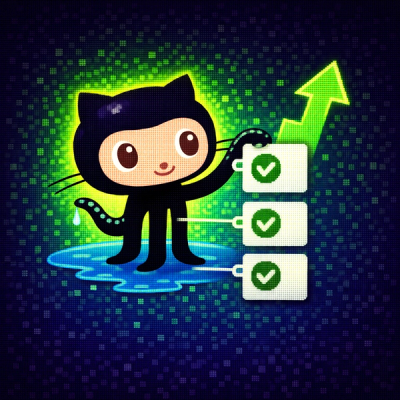
Security News
GitHub Actions Pricing Whiplash: Self-Hosted Actions Billing Change Postponed
GitHub postponed a new billing model for self-hosted Actions after developer pushback, but moved forward with hosted runner price cuts on January 1.
modular-particle-system-webgl-renderer
Advanced tools
Simple WebGL 2 renderer package for modular-particle-system.
Minified size 9 kB. Capable of rendering up to 100 000 particles with smooth FPS (60 times per second).
Available as:
<script src="https://cdn.jsdelivr.net/npm/modular-particle-system-webgl-renderer@1.0.0/index.iife.js"></script>
By using the IIFE build, you can even embed a fully functional particle system + renderer with pure HTML code, for example like this.
npm install modular-particle-system-webgl-renderer
NOTE: Usage from NPM package is currently untested.
// IIFE
const { Renderer } = modularParticleSystemWebglRenderer;
// NPM
import { Renderer } from "modular-particle-system-webgl-renderer";
const imgCloudTexture = new Image();
imgCloudTexture.src = `my-assets/generic/cloud.png`
const textures = {
"generic/cloud.png": imgCloudTexture,
};
const renderer = Renderer({
particleSystem,
container: document.body,
textures,
});
particleSystemReference to a modular ParticleSystem object.
containerReference to a HTML element that will contain the renderer.
texturesTexture sources for rendering particles.
This is a object where each property key describes the name of a texture and the value is a texture source. Several types of values are supported:
ArrayBufferViewImageDataHTMLImageElementImageBitmappixels parameter.autoUpdateIf omitted or true, the renderer will automatically update the ParticleSystem between each frame.
coordinateSystemDefaults to 'pixels'. Can be one of:
'pixels': Particle positions are in pixels, {x:0, y: 0} is at top left corner of container, positive X is right, positive Y is down..
'pixels-centered': Particle positions are in pixels, {x:0, y: 0} is at center of container, positive X is right, positive Y is down.
maxParticlesCountDefaults to 50000, can be used to set a limit for particle rendering.
When number of particles exceeds this, the renderer will render some subset of the particles but not all.
const renderer = Renderer({ ... });
renderer.destroy()
The renderer currently only supports rendering with 1 texture source.
The vision is to allow rendering with a relatively small number of relatively small textures, let's say 10 textures each smaller than 200x200px, since this is within the limits of keeping things simple and performant.
cd modular-particle-system-webgl-renderer
npm i
npm start
FAQs
WebGL 2 renderer for modular-particle-system package
The npm package modular-particle-system-webgl-renderer receives a total of 0 weekly downloads. As such, modular-particle-system-webgl-renderer popularity was classified as not popular.
We found that modular-particle-system-webgl-renderer demonstrated a not healthy version release cadence and project activity because the last version was released a year ago. It has 1 open source maintainer collaborating on the project.
Did you know?

Socket for GitHub automatically highlights issues in each pull request and monitors the health of all your open source dependencies. Discover the contents of your packages and block harmful activity before you install or update your dependencies.

Security News
GitHub postponed a new billing model for self-hosted Actions after developer pushback, but moved forward with hosted runner price cuts on January 1.

Research
Destructive malware is rising across open source registries, using delays and kill switches to wipe code, break builds, and disrupt CI/CD.

Security News
Socket CTO Ahmad Nassri shares practical AI coding techniques, tools, and team workflows, plus what still feels noisy and why shipping remains human-led.